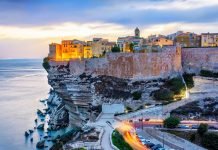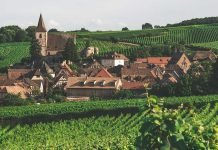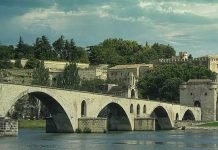The Provence-Alpes-Côte d’Azur region, with its myriad landscapes and natural wonders, truly embodies the essence of a symphony. Each element – be it the sparkling Mediterranean, the serene lavender fields, or the majestic Alps – contributes a unique note to the overall melody, creating a harmony of experiences that resonate within the soul of every traveler.
Highlights of the Region
- French Riviera’s glittering coastline featuring Nice and Cannes.
- Verdant landscapes of the Provence countryside and iconic lavender fields.
- The snow-capped peaks of the Southern Alps.
- Gourmet experiences, from Provencal markets to wineries of Bandol and Cassis.
- Rich art and cultural heritage, with museums like the Fondation Maeght and Musée Matisse.
- The historic significance of the Palais des Papes in Avignon.
- Picturesque medieval villages, such as Eze and Gordes.
- Calanques National Park’s stunning limestone cliffs and azure waters.
- The magnificent Verdon Gorge, also known as the ‘Grand Canyon of Europe.’
- The cultural and architectural wonder that is the Abbey of Thoronet.
Provence-Alpes-Côte d’Azur is a region of alluring dichotomies. It is where the rhythm of the sea’s waves, the perfume of the lavender fields, and the profound silence of the Alps create a compelling melody that enchants every traveler. This southeast corner of France presents a tableau that beautifully illustrates a paradox of environments – from the Mediterranean’s azure expanse to the serene lavender valleys of Provence, and the lofty, snow-adorned peaks of the Southern Alps.
Resplendent Landscapes and Natural Wonders
Provence-Alpes-Côte d’Azur possesses a magnetic charm that extends well beyond the glitzy cities of the French Riviera. It is a repository of nature’s masterpieces – an exhibition of extraordinary landscapes and geological formations that have stood the test of time.
In the heart of this region is the Calanques National Park, a dazzling spectacle nestled between Marseille and Cassis. It’s a sprawling canvas of dramatic limestone cliffs that plunge into secluded beaches and turquoise waters, invoking a sense of awe and wonder. The contrast of stark white rocks against the vivid blue of the Mediterranean is an unforgettable sight, a testament to nature’s grandeur.
Venturing north, another majestic landmark awaits – the Verdon Gorge. Often dubbed the ‘Grand Canyon of Europe,’ it is a stunning manifestation of natural beauty. The emerald-green river cutting through colossal rock formations creates a landscape so breathtaking it seems to belong to a different world. Its precipitous cliffs and vast canyon offer a playground for adrenaline seekers, with ample opportunities for hiking, rock climbing, and water sports.
From the towering alpine ranges to the rolling hills dotted with vineyards, this area of France is a canvas painted with myriad shades of green, forming a picturesque backdrop that seems to leap straight out of an impressionist painting.
The Lavender Fields
In the heart of this lush expanse lie Provence’s iconic lavender fields, their mesmerizing beauty making them a symbol of the region worldwide. These sprawling purple carpets, undulating with the rhythm of the wind, offer a spectacle that is as visually stunning as it is soothing for the senses.
From late June to early August, when the lavender is in full bloom, the fields become a sea of vibrant purple under the clear blue Provençal sky. This visual feast is accompanied by the heady, soothing scent of lavender that fills the air, a sensory experience that encapsulates the essence of a Provençal summer.
The journey of lavender in Provence is intricately tied to the region’s cultural heritage. For centuries, the people of Provence have cultivated lavender, not just for its visual appeal, but for its numerous practical uses. The flower is distilled into essential oil, which is prized for its calming properties and used in a wide variety of products, from perfumes and soaps to candles and culinary delights.
The lavender fields are most often found on plateaus such as the Valensole Plateau, where the sight of row upon row of lavender, interspersed with ancient stone farmhouses and bordered by olive groves and almond trees, creates a picturesque tableau of rural life. As the day progresses, the sunlight subtly shifts the hues of the lavender from deep violet to soft lilac, creating a dynamic and ever-changing landscape.
Visitors can explore these lavender fields through various routes, many of which pass through charming Provençal villages like Sault and Gordes. There are also numerous lavender festivals that celebrate the harvest, offering a chance to participate in traditional festivities, learn about the distillation process, and immerse oneself in the local culture.
The Southern Alps: Majestic Peaks and Valleys
The region’s topography undergoes a dramatic transformation as one travels away from the coast. The Mediterranean’s gentle lull gives way to the quiet grandeur of the Southern Alps. This mountain range, with its snow-dusted peaks and sweeping valleys, paints a picture of serene beauty and wild, untamed nature.
Picturesque alpine towns such as Gap and Barcelonnette perch among these lofty heights, providing charming winter getaways. The powdery snow-covered slopes beckon winter sports enthusiasts, promising days of thrilling skiing and snowboarding.
As winter recedes, the Alps transform. The melting snow breathes life into the region’s flora, converting it into a verdant haven for hikers and cyclists. Trekking trails crisscross the landscape, leading adventurers through tranquil forests, past pristine mountain lakes, and over rugged peaks.
On the fringes of the Southern Alps, the Mercantour National Park is a testament to the region’s biodiversity. Its varied terrain, spanning rugged mountains, crystal-clear rivers, and dense woodlands, provides refuge to an abundance of wildlife. A prime spot for wildlife spotting, the park is home to wolves, chamois, and a stunning array of bird species. This biological richness, paired with the area’s stunning natural beauty, makes it a must-visit destination within Provence-Alpes-Côte d’Azur.
The French Riviera: A Glittering Spectacle
Stretching along the southeast corner of France, the French Riviera, or Côte d’Azur, is a veritable jewel of the Mediterranean. Its mesmerizing azure coastline is adorned with sandy beaches, lush palm trees, and quaint coastal towns, each with its unique charm and character. From the towering yachts docking at the marinas to the luxury hotels and villies dotting the coastline, the Riviera exudes an air of glamour and sophistication that is almost palpable.
Nice: The Colorful Capital of the Riviera
Nice, the largest city on the French Riviera, is a captivating blend of traditional charm and cosmopolitan allure. It gracefully straddles the old and the new, where the rustic charm of the old town, or Vieille Ville, meets the bustling Promenade des Anglais.
The old town is a labyrinth of narrow, winding alleyways packed with colorful houses, traditional Provençal markets, and quaint cafes. One can lose oneself in the exploration of this vibrant district, discovering the Baroque architecture of the Cathédrale Sainte-Réparate or the bustling market of Cours Saleya, famous for its flowers, fresh produce, and antiques.
In stark contrast, the Promenade des Anglais, with its grand Belle Époque architecture, stretches along the city’s magnificent coastline. This iconic boulevard, lined with palm trees and filled with roller-skaters, cyclists, and leisurely walkers, epitomizes the relaxed, sun-soaked lifestyle of Nice. The city’s artistic flair is evident in its numerous galleries and museums, including the Musée Matisse and the Musée Marc Chagall, which houses the largest public collection of the artist’s works.
Cannes: The Jewel of the Riviera
Cannes, another gem of the Riviera, is world-renowned for its annual Film Festival, when stars from around the globe descend upon the city, infusing it with a unique blend of glamour and cinematic passion. The allure of Cannes extends beyond its cinematic heritage. Its elegant boulevards, luxury boutiques, and palatial hotels create an atmosphere of refined luxury.
The city’s charm is not limited to its glamourous facade. The old town, or Le Suquet, offers a stark contrast to the glitz of the city. Its winding, cobbled streets lead to the old castle, now the Musée de la Castre, which offers breathtaking views of the city and the bay.
La Croisette, the city’s famous promenade, is another iconic sight. Bordered by sandy beaches on one side and high-end shops and hotels on the other, it is a place to see and be seen. Watching the luxury yachts dock at the marina while enjoying a chilled glass of Provençal rosé is the quintessential Cannes experience.
Whether you’re drawn to the art and history of Nice or the glamour and luxury of Cannes, the French Riviera offers a taste of the good life, French style. The sparkling sea, the sunny skies, and the unique blend of charm and sophistication make this corner of France an irresistible destination.
A Feast for the Senses: Culinary Delights
The cuisine of Provence-Alpes-Côte d’Azur is a gastronomic journey in itself, evoking the land’s essence and the Mediterranean’s bountiful gifts. Every plate served is a tribute to the region’s agricultural richness, from its fertile inland terrains to its generous coast.
Provence, with its vibrant markets and fragrant gardens, is a cornucopia of fresh produce. Plump tomatoes, juicy melons, fragrant garlic, and a host of herbs like thyme, rosemary, and basil form the basis of many Provençal dishes. The sweet scent of these ingredients, combined with the robust taste of locally pressed olive oil, paints a culinary masterpiece that awakens every sense.
Seafood is the heart of coastal cuisine. From the bustling ports of Marseille to the glamorous tables of Nice and Cannes, you can savour the freshest catches. Bouillabaisse, a traditional Provençal fish stew, epitomizes this marine bounty. Loaded with a variety of fish, shellfish, and infused with aromatic herbs and spices, it’s a dish that captures the spirit of the sea.
Provence is also famous for its vineyards, where rows of vines undulate under the Mediterranean sun. Bandol and Cassis are two regions particularly renowned for their wine production. Bandol wines, deep and full-bodied, carry the hint of the earth and sun, while Cassis offers delicate white wines, embodying the cool sea breezes. Visiting these vineyards offers not just a chance to taste these exquisite wines, but to understand the age-old traditions and meticulous processes behind their creation.
Echoes of the Past: Cultural and Architectural Wonders
The Provence-Alpes-Côte d’Azur region is more than just a geographical wonderland of azure seas, rolling vineyards, and sun-bathed hillsides. It is a living archive of European history, each era’s narrative etched into the landscape and architectural edifices scattered across the region. As one travels through this tapestry of time, you can’t help but feel the echoes of the past resonating in every monument and building, reminiscent of an earlier era.
The city of Avignon, huddled by the Rhône River, stands as an emblem of this historical wealth. Dominating the city’s skyline, the imposing Palais des Papes, with its austere Gothic façade, serves as a dramatic reminder of the time when the papacy made Avignon the epicenter of Western Christianity in the 14th century. As sunlight dances on the palace’s stern countenance, one can’t help but be transported back to a time when the city was an influential hub of religion and politics.
Further stretching back into antiquity, Arles and Orange offer links to a time when the Roman Empire held sway over much of the world. Arles, home to the well-preserved Roman Amphitheatre, once echoed with the roars of the crowd and the clash of gladiator weapons. Now, it stands as a silent testament to Rome’s architectural prowess and their taste for spectacle. Similarly, the Triumphal Arch of Orange, grand and ornate, is a symbol of Roman victory and dominance, its stone-carved inscriptions narrating tales of triumph.
Tucked within the folds of the region’s verdant hills and along its rugged coastline, one can find enchanting medieval villages that serve as charming portals to a bygone era. The village of Eze, precariously perched on a jagged cliff with breath-taking sea views, is like a scene from a fairy tale. Its narrow cobblestone streets and old stone houses weave a captivating story of medieval life. Likewise, Gordes, nestled against the Luberon hills, cascades down the slope in a picturesque tumble of old stone buildings and narrow streets. These towns, unchanged by the march of time, continue to brim with stories, echoing the lives of the people who once walked their streets.
In essence, the Provence-Alpes-Côte d’Azur is more than just a region; it’s a vibrant testament to Europe’s rich past, where cultural and architectural wonders resonate with the echoes of bygone eras. Every stone, every ruin, every village tells a tale, inviting visitors to embark on a journey through time, celebrating the resilience and creativity of human civilization.
The Provence-Alpes-Côte d’Azur region has long served as an inspiration to artists, who have been drawn to its striking light, diverse landscapes, and vibrant colors. This rich artistic heritage is echoed throughout the region’s many museums and galleries, which offer visitors the chance to delve into a world of aesthetic creativity and cultural tradition.
The Fondation Maeght, located in the hilltop village of Saint-Paul-de-Vence, is one such haven for art lovers. With a significant collection of modern and contemporary art, including works by artists such as Joan Miró, Alexander Calder, and Fernand Léger, the museum is a cultural epicenter in the region. Its tranquil gardens are dotted with sculptures, inviting visitors to engage with art in an outdoor setting. The Fondation Maeght offers not just a visual feast, but an immersive artistic experience, with its exhibitions, library, and concert and conference programs.
In the sun-soaked city of Nice, the Musée Matisse stands as a powerful testament to one of the art world’s most influential figures, Henri Matisse. The museum is nestled in a 17th-century Genoese villa surrounded by an olive grove, offering a serene backdrop for the artist’s vibrant works. Housing an extensive collection that spans Matisse’s artistic journey, from his early works to his late cut-outs, the museum provides a unique glimpse into the evolution of the artist’s style and technique. Visitors can not only appreciate his individual works but can also trace the thematic and stylistic shifts across his creative lifespan.
In Coustellet, a newcomer to the region’s cultural scene, the Musée de la Lavande, provides a refreshing departure from traditional art exhibitions. This museum delves into the history and significance of lavender, an iconic symbol of Provence. Through an array of historical exhibits, artifacts, and interactive displays, visitors can explore the journey of lavender from the sun-drenched fields of Provence to its transformation into perfume, oils, and other products. This museum offers an immersive experience, capturing the essence of the region’s natural beauty and its time-honored traditions of lavender cultivation and production.
In conclusion, Provence-Alpes-Côte d’Azur’s museums and galleries serve as gateways into the region’s rich artistic and cultural heritage. From modern art collections to immersive experiences that trace the journey of iconic regional elements like lavender, these institutions offer enriching experiences that go beyond traditional sightseeing, inviting visitors to engage with the region’s identity in a more intimate and profound manner.
In the heart of Provence-Alpes-Côte d’Azur, one can truly appreciate the sublime blending of nature, history, culture, and gastronomy. From the hustle and bustle of the Côte d’Azur to the tranquil beauty of the Provence countryside, and the dramatic landscapes of the Southern Alps, the region offers a cornucopia of experiences for every discerning traveler.

















